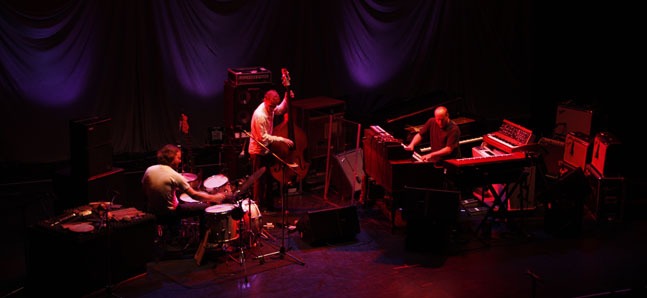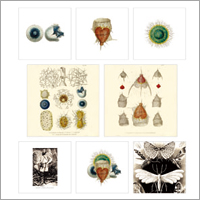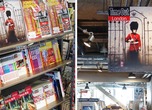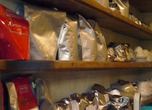
Posted: Wed Apr 21 2010
Medeski, Martin and Wood have been, despite not aspiring to any particular genre, at the forefront of the fusion jazz music scene since their inception in 1991. For nearly 20 years the trio have produced a pile of albums and toured extensively, making live music a mainstay of their careers. They are considered masters of improvisation, and as their close-knit banter shows, these guys are something of a musical organism unto themselves.
MMW played Organic Groove on Saturday April 10 and Sunday April 11, bringing fans of the eclectic sound something to wrap their ears around.
John Medeski (keyboards), Billy Martin (percussion) and Chris Wood (bass) sat down with Time Out Tokyo to talk about Organic Groove, touring, indie labels and their recent four-part ‘Radiolarians’ album cycle.
You guys played Organic Groove last night. How was the set?
CW: Fun.
JM: It was really fun.
BM: It was good.
What is it about Organic Groove that was different or interesting for you to play?
BM: It always seems to be a good pairing for us. Somehow the promoter is able to... it’s like the audience understands what we’re doing. They get a lot of it, we get a lot out of it.
CW: He does set up a good expectation out of the audience that is appropriate for what we do.
JM: I think he actually gets creatively and conceptually involved with the feeling of the show, and we feel that – it inspires us. I think he relates to our music in a way we understand. He goes that little extra couple of yards to make the event mean something, beyond just a show in a club.
Would you say that that supports the improvisational style that you are into now?
BM: Yeah, because improvisation is about the moment, being in the moment, and creating the moment – which requires inspiration, so… the more we have to feed off of, the better.
CW: I look at the promoter [of Organic Groove], as a curator, in the sense that he is an artist, and ‘here’s how we’re going to present them’, it’s not like ‘just stick them in a room and see what happens’.
JM: It’s not like ‘just count the money!’ [Laughs]
CW: He’s also encouraging the artistic side of what we do, instead of any kind of commercial endeavour – he’s trying to create an artistic experience.
JM: And we’re aligned in terms of things we like, like good food, going to shrines…
CW: Yeah, the traditional Japanese kind of culture.
JM: When you travel a lot, like we do, you don’t have a lot of time to travel unless you take a vacation, and that’s hard to do when you have families at home unless you bring them…
CW: Which John did.
JM: I did, this trip, which was a blast – but it’s nice, you know, when you can get a quick entry into things that are hard to find, because you know, you can read tourist books, and you could do the tourist thing, but it’s different, and that is not necessarily as inspiring, especially for doing something artistic, so it’s great when the promoter will go the extra yard – I mean, the thing is with [the promoter], he likes to do these things anyway, he likes to go to onsens [hot springs] and all that stuff… it’s fun. A lot of driving, but fun. It’s worth it.
BM: Like minded.
So with all the travelling and touring, do you bring anything special with you wherever you go? Something that you cannot live without?
CW: Our kitchen.
JM: My blanket.
BM: My teddy bear. [Laughs] Well, we do bring our kitchen case, I guess we do have our little things, our little doodads, they change over the years, but you know, our tea…
CW: We always bring Japanese tea. For 20 years we’ve been ordering sen-cha [a type of green tea] from Japan…
BM: Yeah… yeah...
JM: And matcha [powdered green tea]… we have like a kitchen case that we bring. That’s always been a thing.
Which one of you cooks?
JM: We all do.
BM: John is the master chef.
CW: He’s especially talented at it.
JM: No, but we all do.
CW: We’ve always done that as part of our touring.
BM: But, I guess more importantly are the instruments. John has a collection of keyboards that you can’t get in a regular music store; a lot of them are extinct, you know. And Chris has his special basses, and I have percussion instruments, and 90% of the time we bring them, but we can’t bring them here. For me, I bring percussion instruments, like a suitcase of unique sounds that I can use… those kind of things, yeah, probably when we play those instruments are really special.
You have your own label, Indirecto. What’s changed about you music since you started doing that?
BM: Well, independence is such an important thing, and we pretty much had that spirit from the beginning, and even though we signed on with other labels, we had this independent spirit from the beginning.
JM: Well, we released first one…
BM: Well, we released the first one ourselves, we own it, and now we are right back to it.
JM: Didn’t we squeeze one out in the middle of that?
BM: Yup… mmhm. Yeah, Indirecto’s kind of been around, but basically, when it comes to having our own independent label, and not signed to another label that’s probably when you’re saying [2006], which now, we don’t have to call up a record executive and say, ‘We have an idea, what do you think?’ It’s such bullshit, you know. That’s why we have the Radiolarians series.
CW: We could have never done that if we were on a ‘label’.
BM: Because it doesn’t make money! [Laughs]
JM: In a way, they’re right, from a business point of view it may not be the best decision, but that’s not how we do things.
CW: We didn’t lose money, and we own that music.
JM: We always said that we would make 10 records a year, or a record a month if we had the means and freedom, and this is not the way record companies work. They want to, you know, hold it, so we’ve been able to do things in a completely different way. And it’s great. We can do whatever we want!
CW: So the result is that we have a lot more music in the past two years.
BM: And, in one traditional record cycle we did three records, plus one remix record, a full-length movie…
CW: A children’s record [‘Let’s Go Everywhere’]…
JM: And a record for Jazz One’s label…
BM: A live CD…that kind of thing we could…
JM: Never do that!
BM: It would be so many phone calls, speaking to the manager, the record company, we would just run out of steam – the energy – so that makes it more exciting.
JM: And to feel that it’s ‘ours’, it’s ‘ours’, you know? That’s the way we are, and we’ve always been that way. Maybe we’re the brat independent label? We had really wonderful record situations with labels…
CW: But we never fit in anybody’s mould. We never really were in the jazz mould, we never really wanted to play the jazz clubs, and we chose not to. And as far as marketing is concerned, we knew how to sell our music, so it was always up to us. So we were like, ‘Let’s go tour and bring the music to the people’…
BM: And now everyone is doing it! [Laughs] It was an old idea, though.
CW: But what else are you going to do?
To go back to Radiolarians a little bit; it’s three albums and a remix album. How did that come about?
CW: The idea about how we did it was that we first got together for a few days and wrote all the music, but it wasn’t like, you know, completely finished, written… and then we go on tour and perform that music in front of people, and that’s where it really developed. And then we got back from the tour, got into the studio and recorded it. And that would be one album.
BM: And it was John’s idea that he said ‘Let’s play a season.’ Every season we would have seasonal music, and we’d write it that way. And then it turned into the Viva la Evolution tour, and now it’s Radiolarians. But originally it was a seasonal, like ‘This season we are going to write some music, and we are going to go out and just play that, and then we’re going to record it, and then we’re going to do it again.’
CW: And each record really took a month worth of time, from the tour and then coming back and recording it…
JW: And when we say writing music, it’s very much like jazz. Each piece is open for improvisation, and inspiration dependent on the night, where the song is going to go and how it’s going to work out. And that how we can play these pieces in front of people and get a feel for them, and work them out so when we recorded it just went ‘BAM!’ We recorded quick, almost like a live recording. A couple of days in the studio, it wasn’t live of course, but it felt very live.
CW: Capturing performances.
BM: For us, it was a really good way to do it.
The tours were in very specific parts of the US and Canada [the Northeast US, Southeast US, and Pacific Northwest and Canada]. Did these places influence each part of the cycle?
BM: Probably.
JM: It’s different places in the US, so it’s the same but it’s different.
CW: Without knowing or intellectualising it, I think there are some subtle influences, and developing that music in front of those people, I’m sure that had something.
JW: And the time of the year, that affected it, you know, for sure. And then the places we went to.
CW: You might see it a little bit in the film we made. We made a documentary of ourselves touring and recording, maybe you can see how that process went too.
BM: Going for walks…
CW: Redwoods – that affects you.
Interviewed Sun Apr 11, 2010

‘Evolution in Revolution’
Contrarede/¥2,800
Release date: Mar 3, 2010
Medeski, Martin and Wood
Medeski, Martin and Wood’s ‘Radiolarians: The Evolutionary Set’ 4 CD boxed set is available on Indirecto Records.
Organic Groove: www.organicgroove.net/
Tweets
- About Us |
- Work for Time Out |
- Send us info |
- Advertising |
- Mobile edition |
- Terms & Conditions |
- Privacy policy |
- Contact Us
Copyright © 2014 Time Out Tokyo














Add your comment